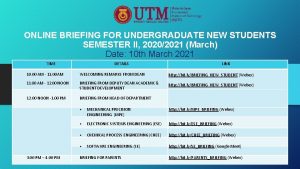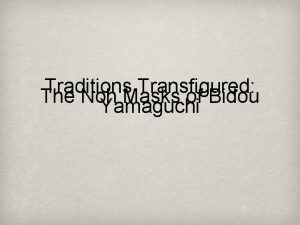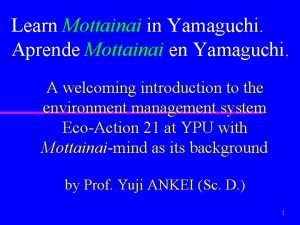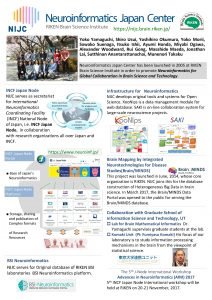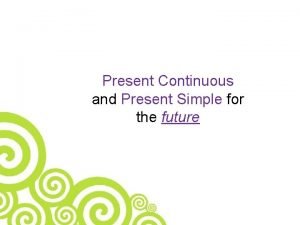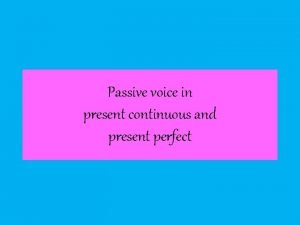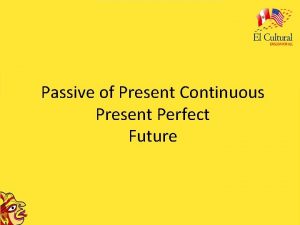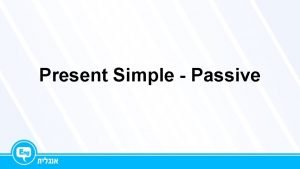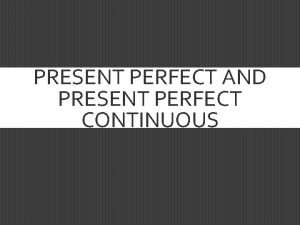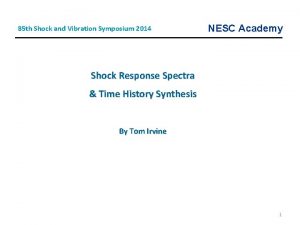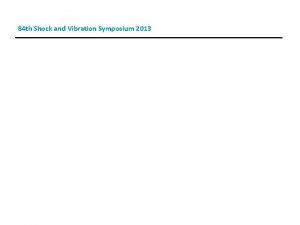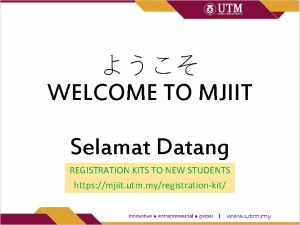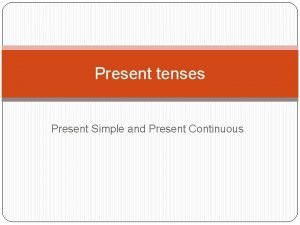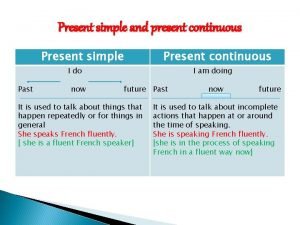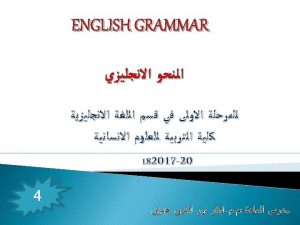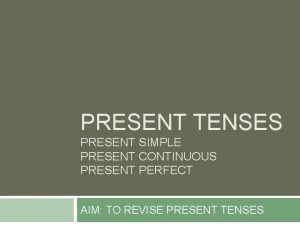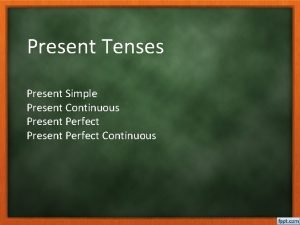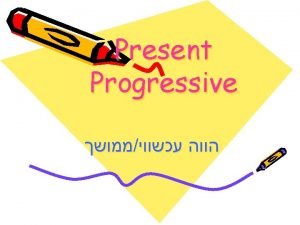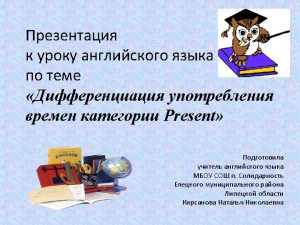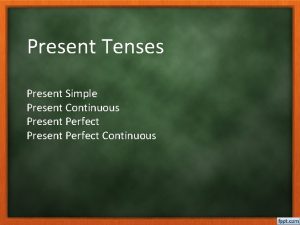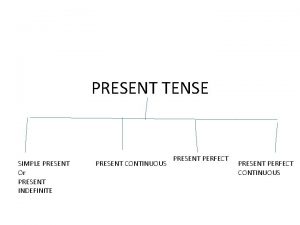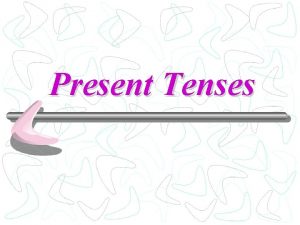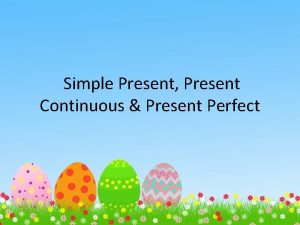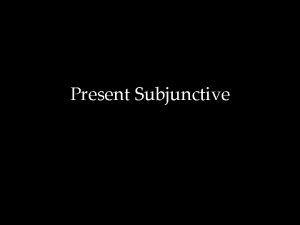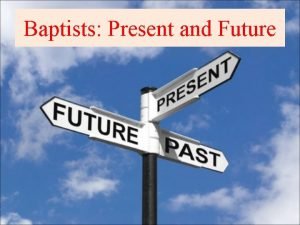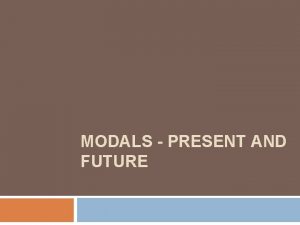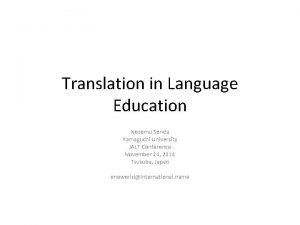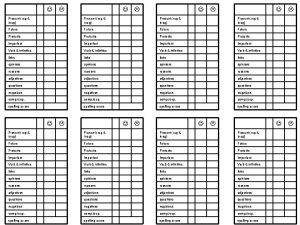Education at MJIIT present and future Symposium Yamaguchi
























- Slides: 24

Education at MJIIT -present and future- Symposium @ Yamaguchi University 14 Nov. , 2015 Fuminori Kobayashi, Deputy Dean MJIIT (on behalf of Dean Rubiyah Yusof, MJIIT )

Based on Strong G 2 G Agreement � G 2 G (government to government) ◦ Tun Dr. Mahathir B Mohamad ◦ Mr. Jun-ichiro Koizumi � Featuring Japanese ◦ Cutting-edge Technologies ◦ Working culture � Final stage of LEP (Look East Policy) ◦ LEP: Study in Japan ◦ MJIIT: Targeted to learn the same in Malaysia

Why MJIIT? You: 1 2 • will receive Japanese-style education in English at affordable cost • will experience the unique working culture of Japanese which places emphasis on responsibility, precision and efficiency 3 • may be selected to do part of their industrial training or visiting universities in Japan 4 • will meet experienced Japanese academicians other than Malaysians and some internationals

Partnership with Japanese Universities JUC: 26 Japanese Universities

Agenda � Introduction � Characteristic Education in MJIIT � MOT-related Education � Future Topic

Uniqueness of Education � Leadership lectures � Curriculum based on Knowledge-Experience and Self-study (KES) pedagogy concept � Holistic approach in Nigenryoku � “Sempai-kohai” relationship through i. Kohza (FYP, Lab assistants from PG) � Mandatory Japanese language courses ◦ Official language is English

Leadership Lecture Series 1. 2. 3. 4. 5. 6. 7. 8. 9. 10. 11. 13/9/2012 29/11/2012 28/2/2013 7/3/2013 … … 26/9/2013 20/2/2014 … 26/2/2015 … Students Prof. Masahiko Horie, UTM Datuk Takashi Hibi, UMW Toyota Motor Tun Dr. Mahathir Mohamad Datuk Aminar Rashid Salleh, Perodua Mr. Chen, Panasonic Tan Sri Rafidah, formerly MITI Datuk Sri Mustapa Mohamed, MITI will serve in the management, not a mere worker, of company.

KES Cycle: Curriculum Base Experience Knowledge 情(emotion) 知(intellect) (A in taxonomy) (C in taxonomy) 意(volition) (P in Taxonomy) Self-Directed Learning Traditional Japanese Pedagogy 8

KES-Based Curriculum Grade 4 TH Self – Directed Learning 3 RD 2 ND KNOWLEDGE EXPERIENCE 1 ST Dominant factor for creativity/novelty 9

Ningen-Ryoku traditionally directly Human Skl Technical Skl Ningen-ryoku Conceptual Skl Richer, smoother unification General culture Practical skill Specialty skill Judge, Decide, Negotiate, Persuade Adapt, Coordinate Lead, etc Goal, Methodology, Identification, Strategy, Thinking skill, Creativity, Problem finding, Planning, etc 10

Ningen-ryoku Program 80 % Confidence Decisiveness Maturity Studen ts gra o r P e ng Excha ms es r u t c e hip L 60 rs Leade (E/M/C) 0 (C) (E) Ningen ryoku 2 ryoku 1 (Professional Ningen(Energy & ethics & ryoku 2 environment safety) Sustainability) Sem 1 Sem 2 Sem 3 (M) (C) Ningen. Nin- ryogen- ku 3 ryo- (MOT) ku 2 Sem 4 (Entrepre. Neurship management) (C) (E/M) Ningen - ryoku 6 (Industrial training) Ningenryoku 5 Ningenryoku 7 (Final year project 1) (E/M)→ Ningenryoku 3 (MOT) Sem 5 Sem 6 Ningenryoku 8 (Final year project 2) Ningenryoku 5 (Entrepre. Neurship management) Ningenryoku 4 (Special lecture & Industry visit) (E only) Sem 7 Sem 8

Career Fair, 2 Apr. 2015 � � � � CANON ELECTRONICS CYPARK RESOURCES DENSO ECOPRASINOS ENGINEERING HIRO FOOD PACKAGES MANUFACTURING HIROSE ELECTRIC HITACHI AIR CONDITIONING PRODUCTS HONDA IHI CORPORATION JAC JFE ENGINEERING JOB SEARCH ASIA JTEKT AUTOMOTIVE KANEKA KOKUYO � � � � KYB-UMW MSM GROUP OMRON ORGANO PANASONIC GROUP COMPANIES PASONA HR PERODUA MANUFACTURING RENESAS SEMICONDUCTOR ROHM-WAKO ELECTRONICS SONY EMCS TAIYO YUDEN TESAC TORAY GROUP UMW TOYOTA MOTOR

What is MOT? Definition of MOT Creative and strategic management of innovations for technology-oriented corporations and organizations to ensure continuing development of new business for the future Engineering Management by the METI, Japan Technology Management MOT Technology Innovation Management

MOT Education Cooperation The only way to realize future based on creativity and innovations. Necessary for the 3 parties to create fruitful learning environment under cooperation and collaboration Academia Industry MOT Accreditation

Characteristics of MOT Systematic Ad hoc � Broad scope of content Diversity in the degree of systemization Degree of systemization � Theory of Organizational Behavior Strategic Management of Technology Scope of Content

Problem of MOT education � What did students acquire? � ⇒Insufficient social recognition Parable of the 7 Blind Men and the Elephant

MOT Education by Yamaguchi Univ. Integrated areas (Specific topical research or other creative activities) Management of innovations Strategic management of technology & R&D intellectual properties Operations management Core knowledge Management of Basic knowledge <MOT fundamentals> ・Introduction to MOT, ・Technology & society, ・Corporate strategy, ・Organization /human resources & corporate ethics, ・Business economics, ・Marketing, ・Accounting & finance Individual content dependin g on each university

MOT Body Of Knowledge: Effect � 4 ◦ ◦ knowledge areas: of of Technology-linked Management Topics General Management Topics Supporting Disciplines 02. 25 - BOK article

Subjects of MOT Taught Course � Mandatory Core Courses ◦ ◦ ◦ � Managing Technology and Innovation Business Planning and Organizing Costing and Financial Organizing Marketing of Technology and Innovative Products Human Resource and Talent Management for Innovation Mandatory Courses ◦ Project 1 & 2 ◦ Research Methodology ◦ University Subject (Japanese Language) ◦ Management Competence Workshops � Specialization and Elective Courses ◦ ◦ ◦ ◦ Finance and Funding of Technology Enterprise Business and Intellectual Property Law Leading Knowledge Workers for Innovation Value Configurations and Competitive Strategy Business Networking and Managing Alliances Managing Technology Change and Transformation Valuation and Intellectual Property Management

Ningen-ryoku Program 80 60 (C) 0 Ningen ryoku 2 ryoku 1 (Professional Ningen(Energy & ethics & ryoku 2 environment safety) Sustainability) Sem 1 Sem 2 Sem 3 Ningen. Nin- ryogen- ku 3 ryo- (MOT) ku 2 Sem 4 (Entrepre. Neurship management) (E/M) Ningen - ryoku 6 (Industrial training) Ningenryoku 5 Ningenryoku 7 (Final year project 1) Ningenryoku 5 (Entrepre. Neurship management) Ningenryoku 4 (Special lecture & Industry visit) Ningenryoku 3 (MOT) Sem 5 Sem 6 Ningenryoku 8 (Final year project 2) Sem 7 Sem 8

Weekly Schedule of Nigenryoku 3 1. 2. 3. 4. 5. 6. 7. 8. 9. 10. 11. 12. Project Management (Introduction), Project X "Honda CVCC" Development of the Small Rocket Intellectual Property Management Corporate Finance and Strategy Project Management (Scope Management and WBS) Project Management (Project Time Mngmnt & Critical Path) Human Resource Management Project Risk Management Theory of Inventive Problem Solving Production Management (Toyota Production System) Simpler Definition of Innovation Project Selection and Portfolio Management

Advantage of Kohza System State of the Art Advantage Innovation Tech. Improvement Ø Continuous R&D Ø R&D Capability Ø Improving together /target of goal with supervisor, Sempai-Kohai, Co-worker Ø Self-Directed Learning Innovative Kohza Ø Sufficient contact with society Ø Evaluation by society/ Transformation Ø Standardized Quality Assurance

Research-directed Education

MOT and Other Research Regions Intellectual Property R&D Strategy Wind Sustainability Enterprise Risk Management Industrial Design Tribo Air MPE VSE ADME CLEAR EGT Creativity Ecological Chemical IDS Innovation Leadership Project Management Nano C ICT CAIRO ESE Embedded Stakeholder Management Standardization Strategy HRD Bio-i. ST ESE(Electric Systems Engineering) MPE(Mechanical Precision Engineering) EGT(Environmental Engineering and Green) MOT(Management of Technology)
 Mjiit registration kit
Mjiit registration kit Bidou yamaguchi
Bidou yamaguchi Bidou yamaguchi
Bidou yamaguchi Yoko yamaguchi
Yoko yamaguchi Exercise future continuous and future perfect
Exercise future continuous and future perfect Future perfect future continuous future perfect continuous
Future perfect future continuous future perfect continuous Symposium introduction
Symposium introduction Present simple and present continuous future
Present simple and present continuous future Nellie to leave for moscow tomorrow
Nellie to leave for moscow tomorrow Present simple present continuous past simple future simple
Present simple present continuous past simple future simple Present simple past simple future simple present continuous
Present simple past simple future simple present continuous Present perfect voice
Present perfect voice Present perfect simple passive
Present perfect simple passive Present simple present continuous past simple future simple
Present simple present continuous past simple future simple To eat au present simple
To eat au present simple Present simple present continuous and present perfect
Present simple present continuous and present perfect Future continuous.
Future continuous. Verbal times
Verbal times Future plans and finished future actions
Future plans and finished future actions Future perfect x
Future perfect x Nulti i prvi kondicional
Nulti i prvi kondicional Wish + present simple
Wish + present simple Shock and vibration symposium
Shock and vibration symposium Navmat p-9492
Navmat p-9492 I write a letter now past continuous tense
I write a letter now past continuous tense
